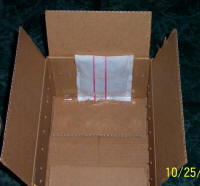Items needed:
- 2 boxes (one box that
fits inside another box) with some air holes punched into it (No
outer air holes in winter)
- Styrofoam packing peanuts
- Pillow case or sock
- Packing tape
- Heat pack if during colder
months. Heat packs are not reliable below freezing temperature.
Place the animal inside a
pillowcase, or a sock if it’s a smaller species. This helps reduce
stress and movement. Put some packing peanuts on the bottom of the
smaller box. Place the animal inside and pack more packing peanuts
around and on top of it. Loose enough so air can still flow, but not
too loose that the animal can move around. I always write the
receivers shipping info on the inside box as a precaution in case the
larger box gets damaged.
Then place some packing
peanuts on the bottom of the bigger box, then place the smaller box
inside the larger box and pack more peanuts around and on top of the
smaller box.
Tape up securely. I usually
mark the box “VERY
FRAGILE” and “THIS
END UP ” “LIVE
HARMLESS REPTILE”
with arrows pointing up. Making a label to be printed up and taped to
the box using a word program makes this easy.
If you are shipping an
aquatic turtle using a Tupperware type container works well with
sphagnum moss or wet paper towels around the sock to keep it moist.
Really small aquatics can be shipped in containers with just sphagnum
moss.
For larger species like
Sulcata tortoises you may have to use Delta Dash and the tort will
have to be shipped in a crate (one for dogs works fine).
Always keep an eye on the
temperature for where you are shipping from and too. If it’s either
too hot or too cold never ship an animal, it could overheat or
freeze.
We follow a shipping season
of April 1st to November 1st. Some shipments can
be made outside of the guidelines depending on temps between where
from and where to a shipment will be made. Always consider the
shippers stopover depots. If shipping must be done in the colder
months use a heat pack (available at
Carolina Pet
Supply).
Shippers:
UPS will ship live animals. Here’s a link their policy:
http://www.ups.com/content/us/en/resources/ship/packaging/guidelines/animals.html?srch_pos=1&srch_phr=live+animals#Accepted+%2F+Prohibited+Live+Animals
You can also set up an account with FedEx to ship live animals,
but that is a bit more involved. I had to send a ‘test’ package
before being approved. You can also ship via Delta cargo, call them
to get specifics: 1.888.SENDPET
USPS does not ship turtles. They will ship some live animals, but
turtles is not one of them.
You have to make the choice to use the shipper you feel most
comfortable with. I always arrange for pick up to be done from my
home at the end of the day.
Always ship Express overnight and only on Monday or Tuesday so
you don’t have to worry about an animal being stuck in a sort
facility over the weekend if anything goes wrong. Occasionally there
may be a delay. If the turtle is packed correctly it will arrive
fine. So always be sure the turtle is packed comfortably and for the
weather and never, ever ship if the weather is questionable, nor
around a holiday.
You can print a label to be taped to the side of the box from
here:
http://www.turtlerescues.org/gallery2/main.php?g2_itemId=3346&g2_navId=xc270613b
Reminder: Heat packs are not reliable below 40° - Do Not Ship!
|

Shipping materials
Materials needed: Inner and outer box, packing peanuts,
sack (pillow case, sock, etc) tape, heat pad if cold,
marker. |

Placement of heat pack.
|

Shipping box side view
All four sides are marked as shown. Air holes are punched in
box unless it's very cold outside. Then no holes in outside
box. |
|

Shipping box bottom view
I mark bottom of box so it's kept upright. |

Tort in sack and placed on bottom layer of packing peanuts.
|

Inside box closed up and secured with
rubber bands or tape. Make sure tort cannot open. |
|

Inside box placed with address
I always place address and phone number of receiver on
inside box. |
 Packing
peanuts placed on top of inside box. |
 All
boxed up ready to go
Label attached and ready for pick up or drop off to DHL.
|
|